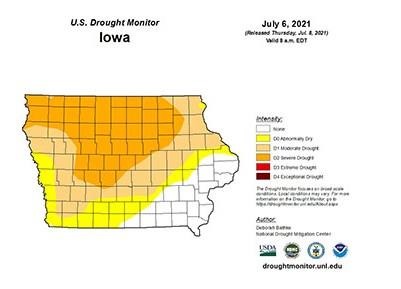Most of northwest Iowa is under moderate or severe drought that is beginning to take a toll on pasture carrying capacity, according to Beth Doran, beef specialist with Iowa State University Extension and Outreach. She reminds producers that changes in management can help extend pasture forage, and offers several suggestions.

Adjust pasture stocking rate. In Iowa, 2 to 2.5 acres are required for continuously grazing a cow-calf pair, depending upon forage species, field slope, soil type and moisture. Normally a cool-season grass pasture takes a minimum of 21-28 days to re-grow early in the grazing season and twice as long in later summer. But, 2021 is not a normal year. It will take more acres to carry a pair, paddocks cannot be grazed as long and forage recovery time will be extended.
Consider early weaning the calves. Early weaning is most successful when calves are a minimum of 90 days of age and have been eating creep feed three weeks. A huge benefit of early weaning is that it reduces the energy demand of the nursing cow by 25-35% so she doesn’t need as much grass to maintain body condition.
Provide mature reproducing beef cows an energy supplement containing monensin. Monensin is an ionophore that can improve feed efficiency in beef cows, reducing feed requirements 5-10% while maintaining body weight and with no negative impact on reproductive performance.
Evaluate supplemental feeds based on cost per unit of energy. The Iowa Beef Center has a “Feed Energy Index” spreadsheet that is free to download (http://www.iowabeefcenter.org/Software/FeedEnergyIndexNE.xls). Good quality hay is high-priced because on-farm hay stocks are 16% lower than a year ago. Watch for other buys – corn screenings, modified distillers grains or wet distillers grains. Bale ditch hay and apply to graze or hay CRP acres.
If the hay crop is light, graze these fields instead of baling. In the long run, this will save money. The cost of baling is significantly higher when the yield per acre is reduced.
Decide which pasture to sacrifice. It is better to ruin and have to reseed one pasture next spring than all of the pastures. A common sign of overgrazing is weeds, especially Musk and Canadian thistles.
Think about your criteria to cull cows. Which females are open, broken mouth, have bad feet, udders or dispositions, or are poor producers? Carefully pencil whether to sell them immediately or feed to add weight. Iowa State research on feeding cows for the white fat market reported feed conversions of 25 pounds of feed per pound of gain.
Source : iastate.edu